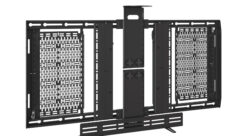A is for AlarmYou have to know alarm system basics yourself beforeyou can safely sell one to someone else.
Feb 20, 1997 12:00 PM,
By Howard E. FriedmanFriedman is a protective technology consultant based in Bayside, NY.
Throughout history, humans have sought to protect their life, property and possessions. In early societies, guards, watchdogs, traps and even noisemakers provided security. Fire was used to baffle wild animals and keep them at bay. In fact, in the opening scenes of the movie, Raiders of the Lost Ark, you see a security system devised to apprehend its violators: When Indiana Jones tripped the mechanism, he was pursued by a huge, rolling boulder. As centuries passed and human accomplishments became more noteworthy, some rather engaging and sophisticated devices were developed to insure man’s security. But until the discovery and harnessing of electricity, no device or protection scheme could be expected to provide any real degree of assurance or consistent peace of mind.
Classifying alarm systemsIn terms of electrical alarms, the vast majority of security systems fall into three broad designs: local alarm, monitored systems and silent alarm.
* Local alarms: The local alarm is a configuration using an audible sound device (a bell or siren) and sometimes a visual one (a strobe light) to report a dangerous situation, be it an intrusion or fire (the two most common conditions), a gas leak or a flood. The notification devices are usually mounted outside the protected premises in order to be in full public view so as to be heard or seen once an alarm has been triggered. Mounting the signaling device this way serves as an effective deterrent to break-ins, especially in residential installations. The major disadvantage of the local alarm is that it may go unnoticed or may not receive any response. In terms of intrusion, such systems really don’t attempt to get anyone’s attention as much as they try to scare off the intruder. Averting or interrupting a break-in is certainly an effective result, even if the intruder is not apprehended by the authorities.
* Monitored systems: A monitored alarm is the most common classification of alarm system used today. Such systems offer local annunciation and provide a link to a central station. Employees at the central stations monitor the status of their subscribers’ alarm systems, usually through automatic telephone contact. When an alarm is received and then verified, an operator or dispatcher will call the appropriate responding authorities and provide them with the details of the alarm.
One of the great advantages of the alarm business is the recurring revenue provided by such an arrangement. Large alarm-installation companies usually have their own central station, which often shares a building with the rest of the company’s operations. Smaller installation companies rent the services of larger national or regional central stations, which may perform monitoring services for hundreds of alarm companies and thousands of subscribers.
* Silent alarms: When it’s neither required nor desired to “announce” an alarm, a silent notification may be used. Silent alarms are usually adjunct to monitored alarm systems and may differ in their purpose, depending on the application. For example, alarm systems owners may want to transmit a notification should they ever come face to face with an intruder. For obvious reasons, it’s important that no local ringing occur that could cause the intruder to panic. In banks and retail commercial installations, special holdup switches are positioned for undetected use. Once activated, the switches send a special signal to the central station, which, in the interests of time and safety, is never verified. Police are dispatched immediately to the site.
At home, one may want a silent medical alarm, activated using the system’s keypad, a wireless neck pendant or a special wristwatch. In such cases, a silent emergency alarm is sent to the central station, and a less intense noise within the premises replaces the loud outdoor alarms that are typical of burglar and fire alarms.
Silent alarms are also used effectively in situations that require non-emergency intervention. This is most often the case in commercial enterprises, in which the alarm system can warn users of equipment problems. For example, if a meat freezer malfunctions at 3 a.m., the owner can be notified. With the flexibility afforded by modern alarm systems, these conditions can be loudly sounded during the day when personnel are on hand and silently reported to the central station at night, when the premises are empty and the alarm system is armed.
Meeting regulationsSome alarm systems serve just one function, such as intrusion or fire. Combination systems have intrusion, fire, medical and environmental protection all in one package, often in a home. (See Figure 1.) Commercial systems are usually more focused and may contain only intrusion or only fire capabilities. Choosing such a fundamental system may be less a function of customer desire and more one of regulation. Regulatory and standard-setting agencies such as Underwriters Laboratories (UL), the National Fire Prevention Association (NFPA) and local jurisdictions usually have a lot to say about larger commercial alarm systems and may require that such installations have separate control panels for intrusion and for fire.
Compliance with the standards set by UL and the NFPA are usually required for the equipment, the configuration and the installation. Fortunately, residential systems are under far less scrutiny and almost always use intrusion and fire capabilities in the same panel.
Residential installations can be hardwired or wireless. A hardwired system depends on the wiring run between its components. Wireless systems, which have been around for 20 years already, use a short-range transmission technology and require only a minimal amount of wiring, usually centered around the control panel. Many of today’s residential systems use wireless technology, which has developed a reliable degree of sophistication, to avoid the time-consuming labor and the difficulties of running wire.
Hybrid systems combine hard-wired and wireless equipment. A hybrid system might be in a home with an alarm system in the detached garage, smoke detectors mounted on a cathedral ceiling and a portable medical transmitter worn by a family member. Hybrid systems may also be found commercially, but where large systems and heavy approvals are required, strictly hardwired systems usually prevail.
Intrusion systems may be further classified into those with only perimeter protection and those with both perimeter and interior detectors.
Alarm system operationAll electric alarms were and are designed to do two basic things: detect a dangerous situation and inform someone of the dangerous condition. Most modern alarm systems include a control panel and at least one keypad on the premises. (See Figure 2.) The system’s many programmable functions allow great flexibility for both the installing company and the end-user.
Most general mechanical and electronic operations revolve around the relationship among three basic concepts: input, process and output. A bathroom scale uses your weight as its input; its internal mechanism processes this information and converts it to a value that is output. The concept is largely the same with thermostatically controlled heaters, videotape players, light-sensitive cameras or virtually any mechanized device.
* Input devices: The input devices in an alarm system are its sensors and detectors, and these come in many types and purposes. Table 1 lists the various types of devices and the appropriate use for each.
* Processing devices: The alarm control panel is the processing device; it’s the unit keeping tabs on all the system’s sensors and detectors. It also supports and communicates with one or more user keypads, which let only those designated to do so operate the system. Such users can select certain modes of operation and issue specific commands. The most basic commands are turning the system’s intrusion protection on or off or generating a medical emergency or a silent holdup alarm. Other keypad commands may silence an alarm in progress; bypass certain sensors, such as allowing a window to be opened for ventilation while the rest of the system is armed; handle home automation functions, such as turning on the coffee pot or opening the front door; or arm the perimeter sensors but not those of the interior, which gives exterior protection while allowing free movement within the premises.
The chime feature is just one of an alarm system’s many processing capabilities. It can be assigned to selected sensors so that they cause a local chirping noise at the keypad whenever they are violated, even while the system is disarmed. For example, parents of young children may want to know whether windows and doors are being opened while the family is at home. With chime selected for such points, the parents can go about their business while listening for any beeps that might indicate the children are doing what they should not.
Small retail store owners may want the chime feature assigned to the front door to serve as an announcer; whenever a customer enters the store during business hours, store personnel are notified by a beep. Once the system is armed, the chime feature is suspended, and any of the same violations will result in a full-fledged alarm.
The alarm control panel must also be able to distinguish between sensors, noting which ones should cause alarms when the system is armed and which should do so at any time. For example, typical intrusion detectors, such as motion sensors and door and window contacts, must be inactive when the panel is disarmed or when the area in which they are located is bypassed. By contrast, a skylight, a fire exit and all smoke, gas and water-level sensors should be programmed as 24-hour devices, capable of sounding an alarm atany time.
Commercial considerationsPanels used in commercial applications add some new dimensions to the processing responsibilities. Large commercial systems often require several valid users. As such, each individual can be given a unique keypad access code; in a system equipped with a fair amount of electronic intelligence, the system can track and record each time an individual uses the system to disarm or arm it. Such activity generates opening and closing signals recorded at the central station for later retrieval by the system’s owner or general manager. These codes reveal users who open late or leave early or try to access the system at odd times. It affords an additional measure of security and can indicate the potential for “inside jobs” or fraudulent use of the system by a particular individual.
User codes may also be assigned authority levels; users with the highest authority levels can use their access code for more than just on and off. These people, usually upper management, may wish to bypass certain areas or to add or delete users from the system. Those given the lowest authority level may only be permitted to arm the system.
Separate but equalNo discussion of alarm systems would be complete without the mention of partitioning. Through miniaturization and creative programming, alarm control manufacturers can design a single panel to act like up to eight separate and distinct systems.
This technology is a blessing for alarm dealers who can protect several stores in a strip mall for far less than they could if separate and discrete systems were used. With partitioning, each subscriber pays less for the installation, and the dealer has up to eight subscribers per panel who, because of monitoring, contribute many times to his monthly recurring revenue.
In residential applications, less sophisticated partitioned panels can be used for two- and three-family houses. The main is in the landlord’s apartment, and the tenants each have one or more keypads and the desired protection. The cost of monitoring can be shared among them, or it can be billed separately.
Output devicesIn alarm systems, the output devices are the announcing and the communicating equipment. Sirens, bells, horns and buzzers produce the audible output. Strobe lights provide visual outputs, which are nearly always used with audible sounders to create attention. (See Figure 3.) An alarm system in an indoor shopping mall would be an ideal place for a strobe because without it, the reverberations of a siren in such an enclosed area may create a degree of confusion for anyone investigating the alarm.
Programming alarm systemsBecause of their complexity, each alarm system must have unique data and operating parameters to suit the installation. Programming fulfills these requirements.Basic programmed data includes:
* The central station phone number.
* The customer’s central station account number.
* The reporting codes for each alarm and the condition and the protocol used in their reporting.
* The keypad access codes for each of the system’s users.
* The authority level corresponding to each access code.
* The desired range of opening and closing times for commercial accounts.
* The type of alarm (burglar, fire, holdup, medical) produced by each of the system’s detectors.
* Which of the system’s intrusion detectors are classified as perimeter or interior.
* If not turned off at the keypad, the duration of the burglar and fire alarm sounders before they time out.
* Information telling the system whether to report trouble conditions to the central station or simply display them on the keypad’s LCD.
Typically, programmed data is transferred to an alarm system in one of several ways: Data can be entered directly from the keypad, one value at a time, or it can be downloaded from a PC. (See Figure 4.) Downloading can be done either through a local connection or a remote one. Local connections require a special cable between the PC’s serial port and the panel.
Remote downloading is far more effective because it can be performed after the installation is completed and from the dealership itself. The same software used to set up each system’s configuration establishes the connection and controls the downloading. Remote programming is easy and convenient, it saves a service call, and it seems to have no disadvantages.
In either case, downloading can transfer the entire configuration at one time, make small corrections to the system, check the current status and recent event history of the system and even disable it for any reason, perhaps for nonpayment.
Most alarm companies program their installations by using software from the control-panel manufacturer. Usually, the employee doing the programming creates a unique configuration file for each system installed by the dealership. Downloading data and parameters to the account by computer can be done either locally or remotely. If done locally, the PC’s serial (COM) port and a special connector on the control panel are connected directly.
Knowledge is powerNow that you have a clear idea of the basics of a security system, you can sell and install one with confidence. The more detailed knowledge you can learn about each product and part of the security loop, the better able you are to serve your customers and provide them with the best security system their money can buy.










